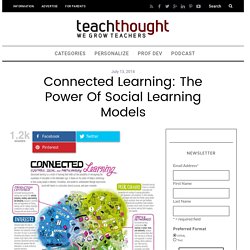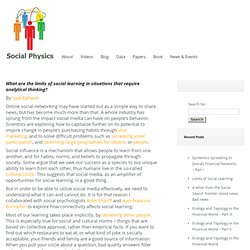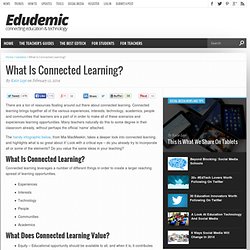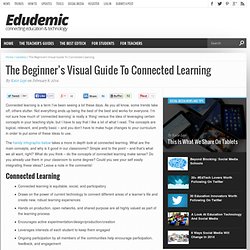

Connected Learning: The Power Of Social Learning Models. Connected Learning: The Power Of Social Learning Models by TeachThought Staff Ed Note: This post was revised and republished from a previous post in 2012.

DML (a “Digital Media and Learning” project), believes in the “the power of participation,” and they’ve created a learning model overview to share their thinking. We recently published our Inside-Out Learning model, an attempt to return the learning to the families, organizations, and communities authentic to the learner. DML’s model is similar in philosophy, underscoring the role of interdependence. Connected Learning in an Open World.
At the beginning of this week I was in Greenwich, London for the first time in my life.

On Monday I travelled up the Thames from Embankment to Greenwich Pier by Clipper (another first) and stood on the decks of the Cutty Sark. On Tuesday I spent the day at the University of Greenwich’s APT2014 Conference, the reason for the trip. On Wednesday I stood on the Meridian Line at the Royal Observatory. A key question asked in the main exhibition room of Flamsteed House at the Observatory is ‘Where am I? This related to how you can work out your exact location on the open seas, by knowing how to fix your latitude and longitude positions. One of the main reasons for attending the conference was to hear Stephen Downes speak. This was the first in a series of 3 talks that Stephen is giving in London this week. I did feel somewhat unfulfilled after the first talk. The points I took from Stephen’s talk were that The issue is not finding innovative ways of teaching, but innovative ways of learning. Connected-Learning-Assessment-Rubric.
Cities of Learning » Why Connected Learning? For more than a century, educators have strived to customize education to the learner.

Connected Learning leverages the advances of the digital age to make that dream a reality — connecting academics to interests, learners to inspiring peers and mentors, and educational goals to the higher order skills the new economy rewards. Six principles (below) define it and allow every young person to experience learning that is social, participatory, interest-driven and relevant to the opportunities of our time. Connected learning thrives in a socially meaningful and knowledge-rich ecology of ongoing participation, self-expression and recognition.
In their everyday exchanges with peers and friends, young people fluidly contribute, share and give feedback. Powered with possibilities made available by today’s social media, this peer culture can produce learning that’s engaging and powerful. Interests foster the drive to gain knowledge and expertise. Limits of Social Learning. What are the limits of social learning in situations that require analytical thinking?

By Iyad Rahwan Online social networking may have started out as a simple way to share news, but has become much more than that. A whole industry has sprung from the impact social media can have on people’s behavior. Scientists are exploring how to capitalize further on its potential to inspire change in people’s purchasing habits through viral marketing, and to solve difficult problems such as increasing voter participation, and searching large geographies for objects or people. Social influence is a mechanism that allows people to learn from one another, and for habits, norms, and beliefs to propagate through society.
But in order to be able to utilize social media effectively, we need to understand what it can and cannot do. Most of our learning takes place implicitly, by observing other people. When the volunteers had to answer the questions on their own, they did badly. Why does any of this matter? Connected Learning. Connected Learning: Harnessing the Information Age to Make Learning More Powerful. 4 Core Principles of Connected Learning. Connected Learning. Connected Learning. What Is Connected Learning? There are a ton of resources floating around out there about connected learning.

Connected learning brings together all of the various experiences, interests, technology, academics, people and communities that learners are a part of in order to make all of these scenarios and experiences learning opportunities. Many teachers naturally do this to some degree in their classroom already, without perhaps the official ‘name’ attached. The handy infographic below, from Mia MacMeekin, takes a deeper look into connected learning, and highlights what is so great about it! Look with a critical eye – do you already try to incorporate all or some of the elements? Do you value the same ideas in your teaching? Connected Learning Explained for Teachers. Connected learning. The Beginner's Visual Guide To Connected Learning. Connected learning is a term I’ve been seeing a lot these days.

As you all know, some trends take off, others stutter. Not everything ends up being the best of the best and works for everyone. I’m not sure how much of ‘connected learning’ is really a ‘thing’ versus the idea of leveraging certain concepts in your teaching style, but I have to say that I like a lot of what I read. The concepts are logical, relevant, and pretty basic – and you don’t have to make huge changes to your curriculum in order to put some of these ideas to use. Connected Learning.